
Protests over the fatal police shooting of unarmed 18-year-old Michael Brown have continued for a 10th night in Ferguson, Missouri. Protesters are calling for the arrest of Ferguson police officer Darren Wilson, who shot the unarmed teenager six times, including twice in the head. According to The New York Times, Attorney General Eric Holder and top Justice Department officials are weighing whether to open a broader civil rights investigation to look at Ferguson’s police practices at large. Meanwhile, the Committee to Protect Journalists has called on the Ferguson Police Department to stop harassing and detaining journalists. At least 11 journalists have been detained while covering the protests sparked by the shooting of Brown. We speak to Ryan Devereaux of The Intercept. On Monday night covering the demonstrations, he was shot by a rubber bullet, arrested and jailed overnight.
Transcript
AMY GOODMAN: This is Democracy Now!, democracynow.org, The War and Peace Report. I’m Amy Goodman, as we broadcast here from Ferguson, Missouri, just outside of St. Louis. Another 47 people were arrested last night in a 10th night of protests over the police killing of 18-year-old Michael Brown. Protesters are calling for the arrest of Ferguson police officer Darren Wilson, who shot the unarmed teenager six times, including twice in the head. A grand jury will begin hearing evidence in the case today.
Meanwhile, Attorney General Eric Holder is scheduled to arrive here in Ferguson soon to meet with FBI agents investigating Brown’s death. According to The New York Times, Holder and top Justice Department officials [are weighing] whether to open a broader civil rights investigation to look at Ferguson’s police practices at large.
Meanwhile, the Committee [to Protect] Journalists [has called on the] Ferguson Police [Department to] stop harassing [and detaining] journalists. At least 11 journalists [have been detained] while covering the protests sparked [by the shooting] of unarmed teenager Michael Brown.
For an update on the latest, we’re joined by Ryan Devereaux of The Intercept. On Monday night, he was shot by a rubber bullet, [arrested and jailed] overnight.
[Ryan], welcome back to Democracy Now! Talk about what [inaudible]. First start with last night.
RYAN DEVEREAUX: Well, last night, Amy, again, protesters took to the streets here in Ferguson on the main sort of thoroughfare where people have been [inaudible] 10 days [inaudible] Florissant, West Florissant Avenue [inaudible]. People [inaudible] last night, basically marching in circles around the area, chanting, protesting over the killing of Michael Brown. For the vast majority of the night, it was peaceful. People were enjoying the opportunity to protest, so they were—had police on either sides of them, heavily armed, militarized police. Around approximately midnight last night, there was a large prayer held. Many people participated. After the prayer, local community leaders, who have been working with the police, were attempting to get young people, sort of young men who were in the area, to calm down, not escalate anything, as that has sort of happened in nights before.
A plastic bottle was thrown at the police, which raised tensions, and things quickly escalated. There was a lot of shouting back and forth. Police were issuing orders to media to disperse, and eventually began—the authorities began pushing the crowd of media and demonstrators back and back and back. People were backpedaling, their hands in the air, chanting “Hands up! Don’t shoot!” the refrain that we’ve heard again and again as protests continue throughout Ferguson. The police were sending camouflaged officers, heavily armed, dressed like soldiers from Iraq or Afghanistan, into crowds of people, pulling people out seemingly at random. I saw a National Lawyers Guild legal observer among those who was pulled away, detained, potentially arrested by these heavily armed, militarized police units last night. It was a chaotic situation, tense at many moments. Police dogs were barking. There was a chopper overhead. People were screaming. People were terrified. And that’s kind of been the way things have been going here. You have a largely peaceful protest for most of the day and most of the evening, and then something will spark, and it will kick off, and then it becomes chaotic quite quickly.
AMY GOODMAN: Talk about what happened to you Monday night, Ryan.
RYAN DEVEREAUX: On Monday night, I was reporting in the same area. Most of the media had been cleared out by the police due to what they deemed a, quote, “public security threat.” They had said to journalists something about shots being fired in the area, but they didn’t offer any details. Most media in the area cleared out. I was with German journalist Lukas Hermsmeier, and we were returning a reporter for the National Post to his car. He had been separated from his car in the area. And we were in the neighborhood where clashes have happened throughout the last week and a half and dropped off the reporter.
As we were trying to find a way to this command center—actually, where we are right now—where the police had directed media to go, I heard over a loudspeaker an announcement: “This is your final warning.” Some number of protesters had returned to the scene despite the media being cleared. I immediately pulled the car over and parked. You know, having heard that this is your last warning, my first instinct was to check out what was going to happen.
I found about two dozen protesters on one side of Florissant Avenue. They had a megaphone. They were taunting the police. A garbage can was set on fire. Some street posts were removed from the ground. On the other side of the street, a separate group of protesters were sort of decrying what the first group was doing, saying, “This is not helping issues.” I crossed the street to interview a young woman who was quite vocal on that side. And as I was beginning to ask her questions, police began firing tear gas canisters in our direction. We moved into a parallel—onto a parallel street in a residential neighborhood. I would continue to speak with this woman. Then the police began coming up the road in armored vehicles, firing more and more tear gas canisters, and also, it appears, shooting rubber bullets out of their vehicle—rubber bullets or bean bag rounds, nonlethal projectiles, as they call them. I actually ran into the young woman that I was interviewing that night last night, and she showed me a wound on her leg that she said was from being shot that night as we were trying to get away. This young woman and her friends piled into a car. They took off.
The German reporter and I were still stuck on the ground, and we were basically separated from our vehicle by a road that was quickly becoming entirely engulfed in tear gas and police who were screening up and down the street in armored vehicles, shooting tear gas canisters and rubber bullets. I saw the police on at least one occasion drive into the residential neighborhood, seeming to be seeking out anyone who was still around, shooting tear gas canisters at them, other nonlethal projectiles at them. We took cover behind a tree for a period of time, trying to ensure that we weren’t going to be hit in the head or body with any of these projectiles.
At one point, we decided that the safest option for us was to walk north on this residential street parallel to the main thoroughfare, Florissant Avenue, and try to get past the cloud, cross the street and back over to our car. We could see through the gaps in the houses, as we were walking, armored police vehicles racing back and forth, up and down the street. At one point, one of those police vehicles turned a left towards us, and it was clear, given the high-powered lights that they have, that they would see us. And we felt that our best option was to immediately identify ourselves as journalists in hopes that they wouldn’t shoot at us.
We put our hands in the air, yelling, “Press! Press! Press! We’re journalists! We’re journalists! We’re journalists!” A police officer on top of an armored vehicle turned his light on us, saw us. There was a pause. He beckoned us to come in his direction. We continued doing so, coming in his direction with our hands up, continuing to yell that we were press. We took a right at the corner where this armored vehicle was parked and continued towards West Florissant Avenue, towards another armored vehicle, where several heavily armed police officers had their rifles trained on us. We were walking towards those officers, moving halfway to three-quarters of the way up this block, when the police officers behind us in the armored vehicle, who had beckoned us over, began opening fire on us with nonlethal projectiles. And I was hit in the back, and the German reporter was hit twice, as well.
At this point, we realized that the police were willing to shoot at us, and we had several similarly armed officers with their guns trained on us directly in front of us and every reason to believe that those officers at any moment would open fire. The fear was that some of them might not be using nonlethal rounds. So we dove behind a car to take cover. And the police basically surrounded us, pulled us out of there, zip-tied our hands behind our backs, threw us in the back of their armored vehicle, drove us to this command center, where we were informed that we were being arrested, that we would be taken to the county jail, unclear as to why or for what charges.
We repeatedly identified ourselves as journalists. They asked us why we were out. I told them, the same reason that they were out, that we had a job to do, that as journalists it’s our job to be out here. They took us to the jail, and we were held for approximately 18—or, I’m sorry, eight hours. The closest we got to an explanation for our detention was they told us we were being charged with refusal to disperse. I was released yesterday morning, and I’m continuing to report.
AMY GOODMAN: And who else was in the jail where you were?
RYAN DEVEREAUX: So, there were at least two dozen or so young men that we were speaking to throughout the course of the night that we saw come in. The police initially said that 31 people were arrested over the course of that night, but as it turns out, according to NBC News, the number was much higher than that, significantly higher. These young men were a lot of young men from the community, young African-American men who have been demonstrating for days now, frustrated with not just the killing of Michael Brown, but the general treatment of members of the community by the police.
AMY GOODMAN: Ryan Devereaux, I want to turn to the clip of Ron Johnson, who is the highway security captain who was put in charge of security here in Ferguson, talking about the arresting of journalists.
CAPTAIN RON JOHNSON: I’m going to tell you, in the midst of chaos, when officers are running around, we’re not sure who’s a journalist and who’s not. And yes, if I see somebody with a $50,000 camera on their shoulder, I’m pretty sure. But some journalists are walking around, and all you have is a cellphone, because you’re from a small media outlet. Some of you may just have a camera around your neck. So, yes, we are—we may take some of you into custody. But when we do take you into custody and we have found out that you’re a journalist, we have taken the proper actions. But in the midst of it, we cannot—in the midst of it, in the midst of chaos and trying to move people on, we have to be safe.
AMY GOODMAN: That was Captain Ron Johnson. Ryan Devereaux, a $50,000 camera and he pretty much knows you’re a journalist?
RYAN DEVEREAUX: Yeah, that seems like a pretty ridiculous request of journalists. The vast majority of us are not out here walking round with $50,000 cameras. That’s just not the way media works anymore. And he also said that, you know, once a person has identified themselves as a journalist, then they will—the authorities will make every effort to make sure that they are released. That was not the case for us. In the case of our arrest, we identified ourselves immediately, and then we were shot in the back by police officers.
AMY GOODMAN: And how did it compare to last night, the treatment of people in the street?
RYAN DEVEREAUX: Last night was an interesting night, because there were so many media out. There was so much media. There was a really heavy media presence on the street on West Florissant Avenue. And the police were repeatedly requesting the media to move to this designated area, very unclear as to why. And the media was standing its ground and sort of refusing to separate itself from the crowd of demonstrators that were there for quite some time. Eventually the police did manage to get everyone to start moving. And with all of these cameras on them, the police officers still continued to sort of surge into the crowd and pluck people out, and in some really disturbing and violent ways.
AMY GOODMAN: I wanted to play for a moment President Obama. It was on Thursday, last Thursday, when he criticized the Ferguson Police Department for its treatment of journalists.
PRESIDENT BARACK OBAMA: There is never an excuse for violence against police or for those who would use this tragedy as a cover for vandalism or looting. There’s also no excuse for police to use excessive force against peaceful protests or to throw protesters in jail for lawfully exercising their First Amendment rights. And here in the United States of America, police should not be bullying or arresting journalists who are just trying to do their jobs and report to the American people on what they see on the ground.
AMY GOODMAN: That’s President Obama. Ryan Devereaux, his comment about journalists?
RYAN DEVEREAUX: Well, it’s interesting to hear this administration talking about journalists in that way, because we’re talking about an administration that has cracked down on whistleblowers and sources and journalists in an unprecedented way, far more aggressive than any—all administrations before combined. I mean, it’s refreshing to hear, but we would like to see those sort of concerns extended not just to journalists who are covering protests, but also journalists who are covering important national security stories that require dealing with confidential sources.
AMY GOODMAN: James Risen says that President Obama has cracked down—is the worst president when it comes to crackdown on journalists, just recently said this, The New York Times reporter, who was having his own news conference right about the time that President Obama was talking about Ferguson’s treatment of journalists on Thursday. He and many others were involved with delivering 100,000 signatures to the White House, the Justice Department, around the issue of James Risen and the U.S. government’s attack on him, the possibility that—because the Supreme Court has refused to hear his case, that he will not reveal a source, The New York Times reporter, he could possibly go to jail.
RYAN DEVEREAUX: Well, if anyone knows about this administration’s crackdown on journalists and sources, it’s James Risen. He’s one of the world’s probably most important investigative journalists, and he has felt the full force of this administration and its sort of efforts to go after those who receive leaks that are not sanctioned by the administration, not sanctioned by the White House. Our media is awash in national security leaks, but oftentimes they’re leaks that paint the administration or the White House in a favorable light. There’s no crackdown on the journalists who are reporting from those sources. But when people like James Risen come out with stories that, you know, detail real problems in the national security state, the administration goes after them, and it’s a serious problem.
AMY GOODMAN: Well, Ryan Devereaux, I want to thank you very much for being with us. Ryan Devereaux is a reporter with The Intercept, was arrested on Monday night. And even as I say goodbye to you, one last question: how this compares to your experience of Occupy, which you covered extensively when you were working at Democracy Now!, the Occupy movement in New York?
RYAN DEVEREAUX: Well, the police here in Ferguson, unlike the NYPD, they come out dressed as sort of stormtroopers in full military gear. And it doesn’t seem to be the case that they have the experience working with large crowds that the NYPD does. They almost manage to make the NYPD, which detained, you know, hundreds and hundreds of people over the course of Occupy, you know, pepper-sprayed people, beat protesters—the police here almost make the NYPD look good in their sort of handling of crowds.
AMY GOODMAN: Ryan Devereaux, thanks so much. And he will be out on the streets again, as we continue to cover what’s happening here in Ferguson, as we broadcast from Ferguson, Missouri. This is Democracy Now! We’ll be back in a minute.

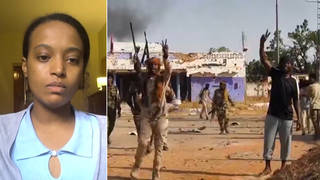
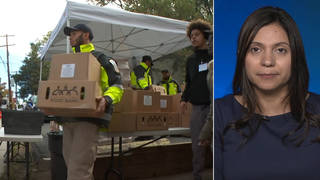
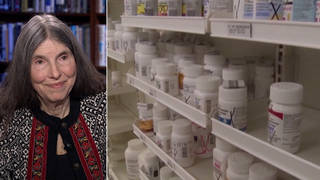
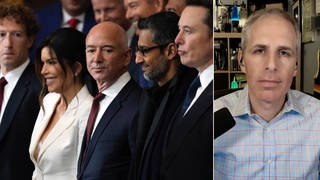





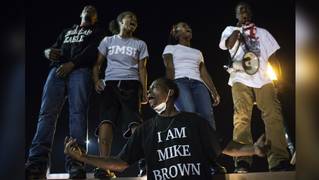

Media Options